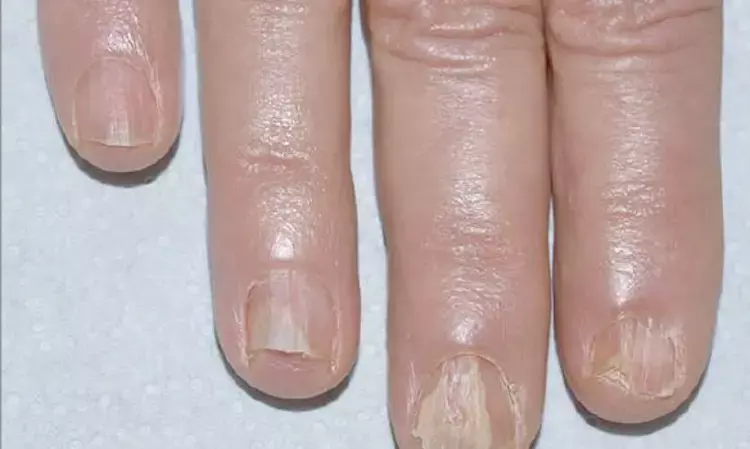- Home
- Medical news & Guidelines
- Anesthesiology
- Cardiology and CTVS
- Critical Care
- Dentistry
- Dermatology
- Diabetes and Endocrinology
- ENT
- Gastroenterology
- Medicine
- Nephrology
- Neurology
- Obstretics-Gynaecology
- Oncology
- Ophthalmology
- Orthopaedics
- Pediatrics-Neonatology
- Psychiatry
- Pulmonology
- Radiology
- Surgery
- Urology
- Laboratory Medicine
- Diet
- Nursing
- Paramedical
- Physiotherapy
- Health news
- Fact Check
- Bone Health Fact Check
- Brain Health Fact Check
- Cancer Related Fact Check
- Child Care Fact Check
- Dental and oral health fact check
- Diabetes and metabolic health fact check
- Diet and Nutrition Fact Check
- Eye and ENT Care Fact Check
- Fitness fact check
- Gut health fact check
- Heart health fact check
- Kidney health fact check
- Medical education fact check
- Men's health fact check
- Respiratory fact check
- Skin and hair care fact check
- Vaccine and Immunization fact check
- Women's health fact check
- AYUSH
- State News
- Andaman and Nicobar Islands
- Andhra Pradesh
- Arunachal Pradesh
- Assam
- Bihar
- Chandigarh
- Chattisgarh
- Dadra and Nagar Haveli
- Daman and Diu
- Delhi
- Goa
- Gujarat
- Haryana
- Himachal Pradesh
- Jammu & Kashmir
- Jharkhand
- Karnataka
- Kerala
- Ladakh
- Lakshadweep
- Madhya Pradesh
- Maharashtra
- Manipur
- Meghalaya
- Mizoram
- Nagaland
- Odisha
- Puducherry
- Punjab
- Rajasthan
- Sikkim
- Tamil Nadu
- Telangana
- Tripura
- Uttar Pradesh
- Uttrakhand
- West Bengal
- Medical Education
- Industry
Barcitinib effective in severe nail lichen planus- 1st case report

Source- Pünchera J, Laffitte E. Treatment of Severe Nail Lichen Planus With Baricitinib. JAMA Dermatol. 2021 Dec 8. doi: 10.1001/jamadermatol.2021.5082. Epub ahead of print. PMID: 34878494.
Barcitinib effective in severe nail lichen planus- 1st case report - Lichen planus (LP) is an inflammatory disorder of the skin and mucous membranes. LP of the nails occurs in approximately 10% of patients, commonly involves multiple nails and can lead to scarring of the nail matrix and possible complete loss of the nail plate.2 Nail lichen planus (NLP) is a notoriously difficult to treat nail disorder with high rates of therapeutic failures or relapses. Recently an article describing use of barcitinib in severe recalcitrant NLP was published in the Journal of American Academy of Dermatology.
A woman in her 60s presented with 1 year history of a severe nail dystrophy of all fingers of both hands. Onychomycosis was ruled out by direct examination as well as results of a culture of nail specimens. Presence of longitudinal ridging and fissuring, distal splitting, and trachyonychia led to a clinical diagnosis of severe NLP. No other cutaneous mucosal involvement was seen in the patient. Patient's NLP had been treated with 5 intramuscular triamcinolone injections (40mg per month) followed by oral acitretin (25mg, daily) for 5months without any improvement. Later methotrexate was administered to the patient which showed some efficacy but was discontinued because of adverse effects, such as fatigue and a lowering of her work capacity. The authors then began treatment with baricitinib 4mg daily which led to substantial improvement in 2months and complete clearance at 6 months.
At eleventh month of treatment, the daily dose was reduced to 2mg with limited disease recurrence on 1 finger. The patient remained satisfied with her disease control so she was maintained at 2mg daily.
In NLP depending on nail matrix or bed involvement the clinical picture differs. Commonly the nail matrix is affected leading to lateral thinning with longitudinal ridging and fissuring of the nail and finally dorsal pterygium formation. Nail bed NLP results in subungual hyperkeratosis, onycholysis, nail bed atrophy and even anonychia.
Because of the unpredictable course and potential dystrophic nature of NLP early diagnosis and prompt treatment are crucial and essential. Lac of robust data has led to treatment recommendations for NLP based on expert opinions, case series, or case report only. Unfortunately, the response to these treatments is often unsatisfactory. Use of tofacitinib in LP has been reported.
The JAK2 is considered the cornerstone of the pathogenesis of LP. Thus the authors administered baricitinib, an oral highly selective JAK1/2 inhibitor which has a good safety profile resulting in rapid and sustainable improvement without any adverse effects.
To conclude baricitinib may be a promising therapy for severe NLP which is normally tough to treat with unsatisfactory results with other treatments.
Source-
1. Pünchera J, Laffitte E. Treatment of Severe Nail Lichen Planus With Baricitinib. JAMA Dermatol. 2021 Dec 8. doi: 10.1001/jamadermatol.2021.5082. Epub ahead of print. PMID: 34878494.
2. Arnold DL, Krishnamurthy K. Lichen Planus. [Updated 2021 Sep 13]. In: StatPearls [Internet]. Treasure Island (FL): StatPearls Publishing; 2021 Jan-. Available from: https://www.ncbi.nlm.nih.gov/books/NBK526126/
MBBS
Dr Manoj Kumar Nayak has completed his M.B.B.S. from the prestigious institute Bangalore medical college and research institute, Bengaluru. He completed his M.D. Dermatology from AIIMS Rishikesh. He is actively involved in the field of dermatology with special interests in vitiligo, immunobullous disorders, psoriasis and procedural dermatology. His continued interest in academics and recent developments serves as an inspiration to work with medical dialogues.He can be contacted at editorial@medicaldialogues.in.
Dr Kamal Kant Kohli-MBBS, DTCD- a chest specialist with more than 30 years of practice and a flair for writing clinical articles, Dr Kamal Kant Kohli joined Medical Dialogues as a Chief Editor of Medical News. Besides writing articles, as an editor, he proofreads and verifies all the medical content published on Medical Dialogues including those coming from journals, studies,medical conferences,guidelines etc. Email: drkohli@medicaldialogues.in. Contact no. 011-43720751


